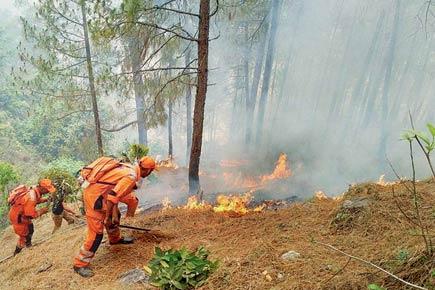Forced to switch on the AC in Dehradun, this columnist ponders on how the hill station too is paying the price for development

 Almost 20 years ago, my parents moved from Calcutta to Dehradun. At the time, the Doon Valley was known for its educational institutions and as a retirement paradise — surrounded by hills and forests, ice-peaked Himalayas visible a short journey away, litchi-filled orchards and the promise of escape from the hellish hustle of a city.
Almost 20 years ago, my parents moved from Calcutta to Dehradun. At the time, the Doon Valley was known for its educational institutions and as a retirement paradise — surrounded by hills and forests, ice-peaked Himalayas visible a short journey away, litchi-filled orchards and the promise of escape from the hellish hustle of a city.

NDRF personnel extinguish a fire in the forests of Pauri Garhwal earlier this month. The hills have been full of forest fires through April and May. Pic/PTI
ADVERTISEMENT
When the locals saw that my parents had brought air-conditioners with them, they laughed. The first reason was practical. The village my parents had selected did not get electricity all that often and when it did, the neighbourhood wiring could not support air-conditioners. The other reason was more romantic and pointed to why they had come to Doon in the first place: the weather was such that you barely needed air-conditioners.
In April, you used a quilt at night and sometimes, you did not even need a fan. Cold mountain air came down from Mussourie. In May and June — for about four weeks — it did become hot enough to warrant a few desert coolers. But hot is relative. The worst I have suffered is 47 degrees during four summers in Ahmedabad and anyone can tell you that the sweaty heat of Calcutta is a torture that would fit well in Dante’s descriptions of hell.
Today, I succumbed to the terrible eco-unfriendly demands of an air-conditioner in Dehradun. Yes, the electricity supply had improved. Yes, even in this village, some 3,000 feet above sea level and somewhat more remote than my parents’ first stop, the wiring can take it. Because now we have apartment blocks and shopping malls around us, WiFi, no litchi orchards and if it looks like paradise to you when you visit, it is because you don’t know what it used to be like.
This April, the hills were full of forest fires as has been extensively talked about and reported on TV and in the papers. Last year’s monsoon was short and scanty and much-needed winter rains took a rain check. The temperature in our garden last month was 50 degrees according to our thermometer at home. The weather department puts it at 40 degrees today and the Internet’s weather sites at 43 degrees Celsius. The hill station of Mussourie is a mere 45-minute drive from our village, if that puts it into perspective. Old-timers say they have never known it like this.
The monsoon, which will bring much-needed relief, is not expected until the end of June. But the price that I have paid by giving in to air-conditioning sits heavily on my conscience — the delicious, guilty relief of escape from searing heat notwithstanding. Hypocrisy on my part, I know. I can see the environmental degradation around me.
I know that our river courses are running dry. I see that builders are given free rein to destroy as many trees and as much open land as possible. I can see what happens when you make ‘development’ into a nationalistic mantra without a thought for consequences.
Right now, we have not yet felt the effect of last year’s rain and snow shortfall. It will happen though. The Tehri lake is at its lowest point and that is Uttarakhand’s big hydroelectric dream. The Nainital lake is also as low as it has ever been and that is one of Uttarakhand’s big attractions. Tankers are running up and down the hills squeezing every last drop from any available water body. Soon, I expect both water and electricity to vanish and so much for my big investment.
The best that I can come up with as points of solace are that the brilliant orange-red gulmohur and bright yellow Indian laburnum trees are looking particularly resplendent this season while the purple jacaranda is fading. And there is some old wives’ tale about how mangoes taste better in the heat.
You might say I’ve caught a bit of May madness. Haven’t we all!
Ranjona Banerji is a senior journalist. You can follow her on twitter @ranjona
 Subscribe today by clicking the link and stay updated with the latest news!" Click here!
Subscribe today by clicking the link and stay updated with the latest news!" Click here!







